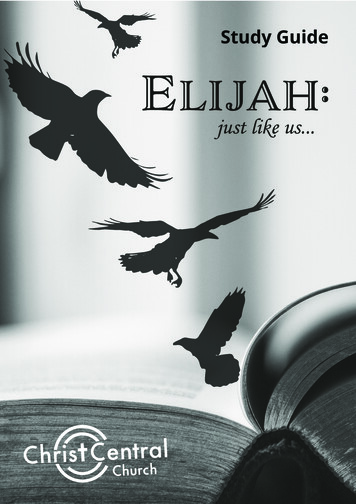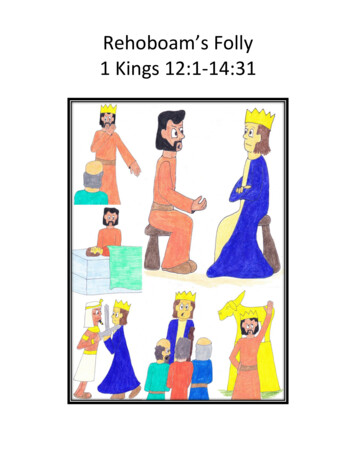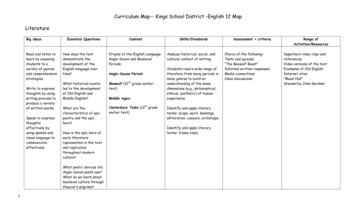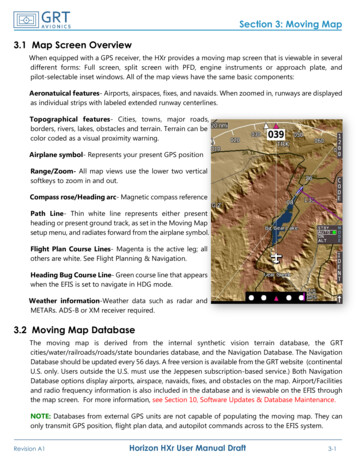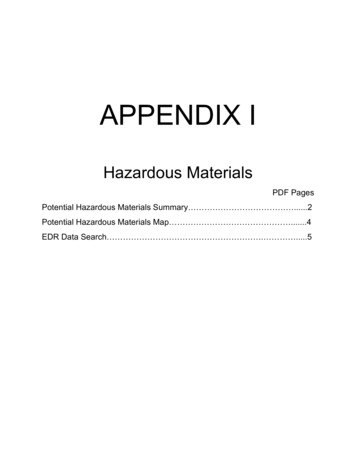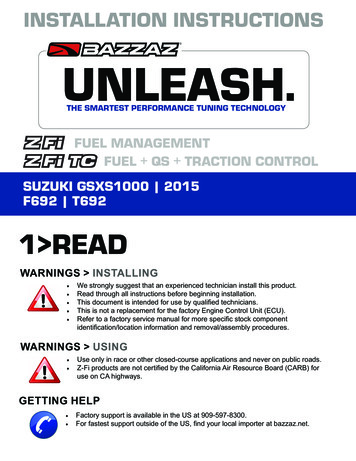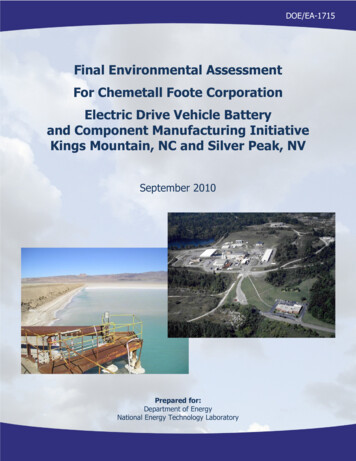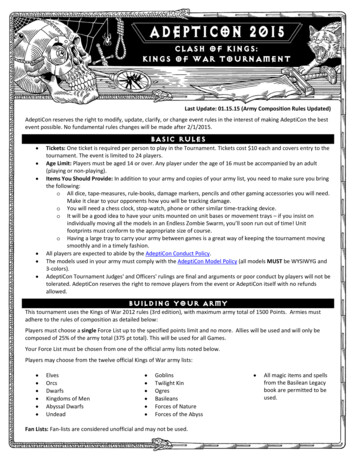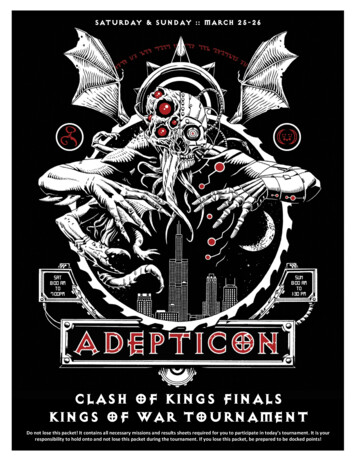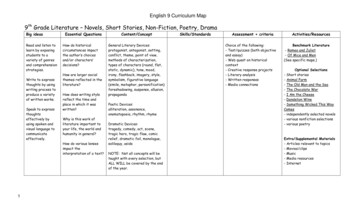
Transcription
English 9 Curriculum Map9th Grade Literature – Novels, Short Stories, Non-Fiction, Poetry, DramaBig ideasRead and listen tolearn by exposingstudents to avariety of genresand comprehensionstrategies.Write to expressthoughts by usingwriting process toproduce a varietyof written works.Speak to expressthoughtseffectively byusing spoken andvisual language tocommunicateeffectively.Essential QuestionsHow do historicalcircumstances impactthe author’s choicesand/or characters’decisions?How are larger socialthemes reflected in theliterature?How does writing stylereflect the time andplace in which it waswritten?Why is this work ofliterature important toyour life, the world andhumanity in general?How do various lensesimpact theinterpretation of a text?1Content/ConceptGeneral Literary Devices:protagonist, antagonist, setting,conflict, theme, point of view,methods of characterization,types of characters (round, flat,static, dynamic), tone, mood,irony, flashback, imagery, style,symbolism, figurative language(simile, metaphor, personification)foreshadowing, suspense, allusion,propagandaPoetic Devices:alliteration, assonance,onomatopoeia, rhythm, rhymeDramatic Devices:tragedy, comedy, act, scene,tragic hero, tragic flaw, comicrelief, dramatic foil, monologue,soliloquy, asideNOTE: Not all concepts will betaught with every selection, butALL WILL be covered by the endof the year.Skills/StandardsAssessment criteriaChoice of the following:- Test/quizzes (both objectiveand essay)- Web quest on historicalcontext- Creative response projects- Literary analysis- Written responses- Media connectionsActivities/ResourcesBenchmark Literature- Romeo and Juliet- Of Mice and Men(See specific maps.)Optional Selections- Short stories- Animal Farm- The Old Man and the Sea- The Chocolate War- I Am the Cheese- Dandelion Wine- Something Wicked This WayComes- independently selected novels- various nonfiction selections- various poetryExtra/Supplemental Materials- Articles relevant to topics- Movies/clips- Music- Media resources- Internet
English 9 Curriculum Map9th grade Benchmark Literature – Romeo and JulietBig ideasRead and listen tolearn by exposingstudents to avariety of genresand comprehensionstrategies.Write to expressthoughts by usingwriting process toproduce a varietyof written works.Speak to expressthoughtseffectively byusing spoken andvisual language tocommunicateeffectively.Essential QuestionsHow has Shakespeareinfluenced contemporarylanguage and culture?How do the maincharacters exemplifythe tragic hero, and whattragic flaw(s) do theyexhibit?To what extent dovarious characters withinthe play share culpabilityfor the outcome?What universal themesare present in the play,and how are theyrelevant today?Content/ConceptDramatic terms and structureElizabethan syntax and languageevolution: reading ShakespeareIntroduction to Shakespeareanhistory: life, theatre, and timeperiodIdentification and application ofdramatic and literary elements,including meter, sonnet, blankverse, tragedy, comedy, tragichero, tragic flaw, metaphor,simile, oxymoron, monologue,soliloquy, aside, irony,symbolism, foreshadowing, foilcharacter, allusion, imagerySkills/StandardsAnalyze historical, social, andcultural context of setting.Explain how various literarytechniques are used to shape theplot and meanings of a literary text.Evaluate how the author’s use oflanguage shapes meaning and tone ina text.Analyze how characters developover the course of the text,interact with other characters, andadvance the plot or develop thetheme.Determine central ideas or themesof a text and analyze theirdevelopment; cite key supportingdetails and ideas.Analyze how the author structuresa text, orders events within it, andmanipulates time.Explain how the author uses symbolsand figurative language to createbroader meanings.2Assessment criteriaActivities/ResourcesChoice of the following:-Tests and quizzes- Informal written responses- Media connections- Class readings/discussions- Creative response projects- Literary analysis- Dramatic presentations- Media connections- The Tragedy of Romeo & Juliet- Supplemental materials such ashistorical articles, music, relatedmovies/clips, media resources,etc.
English 9 Curriculum Map9th grade Benchmark Literature – Of Mice and MenBig ideasRead and listen tolearn by exposingstudents to avariety of genresand comprehensionstrategies.Write to expressthoughts by usingwriting process toproduce a varietyof written works.Speak to expressthoughtseffectively byusing spoken andvisual language tocommunicateeffectively.3Essential QuestionsContent/ConceptHow are the philosophiesof Social Realists and/orNaturalists displayedwithin the novel?Introduction to Steinbeck’s lifeand influencesHow are racial, gender,and societal stereotypesexamined within thenovel?To what extent do ourenvironment, heredity,and circumstances shapeour destiny?Historical Context:Social Realism/NaturalismThe Great DepressionLiterary Devices:Point of view, setting, conflict,theme, tone, methods ofcharacterization,foreshadowing, symbolism,motifs, religious archetypes inliteratureSkills/StandardsAnalyze historical, social, and culturalcontext of setting.Explain how various literary techniques areused to shape the plot and meanings of aliterary text.Evaluate how the author’s use of languageshapes meaning and tone in the text.Cite textual evidence to support bothexplicit and implicit messages within thetext.Analyze how characters develop over thecourse of the text, interact with othercharacters, and advance the plot or developthe theme.What are the dominantthemes of the novel, andhow do the setting andsocial context contributeto those themes?Determine central ideas or themes of a textand analyze their development; cite keysupporting details and ideas.What symbols, motifs, orreligious archetypes arepresent in the novel, andhow do they enhance thedevelopment of themes?Analyze how the author structures a text,orders events within it, and manipulates time.Analyze the author’s use of point of view,mood, and tone.Explain how the author uses symbols, motifs,and foreshadowing to create broadermeanings.Assessment criteriaActivities/ResourcesChoice of the following:- Tests and quizzes- Informal written responses- Media connections- Class discussions- Historical research- Creative response projects- Literary analysis- Media connections- Of Mice and Men- Supplemental materials such asshort stories, historical articles,music, related readings, relatedmovies/clips, media resources,etc.
English 9 Curriculum Map9-12 Independent ReadingBig ideasEssential Questions1.1. Read and listento learn byexposing studentsto a variety ofgenres andcomprehensionstrategiesWhat are thebenefits of beinga life-longreader?ContentIndependently chosen booksSkills/Standards1.Independently readbooks for variouspurposes.2. Apply literary skills toindependently chosenbooks.Assessment criteriaActivities/ResourcesVarious creative projectsSchool media centerTestsPublic libraryWriting responsesBook recommendationsSpeeches to conveyunderstandingPosters2. Write toexpress thoughtsby using writingprocess to producea variety of writtenworks3. Speak toexpress thoughtseffectively byusing spoken andvisual language tocommunicateeffectively.4ProjectsWriting assignmentsBook talks
English 9 Curriculum MapVocabulary 9-12Big ideasRead and listen tolearn by exposingstudents to avariety of genresand comprehensionstrategies.Write to expressthoughts by usingwriting process toproduce a varietyof written works.Speak to expressthoughtseffectively byusing spoken andvisual language tocommunicateeffectively.Essential QuestionsHow is meaning derivedfrom word patterns (e.g.,roots, prefixes,suffixes)?How does an expansiveand growing vocabularybase add to a person’soverall ability tocommunicate?How can the meaning ofunfamiliar vocabularywords be understoodthrough context clues?ContentPower Plus for the New SATContent vocabulary fromliterature units.Skills/StandardsAnalyze the relationships ofpairs of words in analogicalstatements (e.g., synonyms andantonyms, connotation anddenotation) and evaluate theeffectiveness of analogousrelationships.Use knowledge of Greek, Latinand Anglo-Saxon roots, prefixesand suffixes to understandcomplex words and to recognizethe relationships betweenwords.Clarify meaning of unknownwords through the use ofstrategies such as semantic(context) clues, syntax clues,and the use of referencematerials.Distinguish a word from otherwords with similar denotationsbut different connotations.Use grade-appropriatevocabulary in writing.5Assessment criteriaTests/quizzesRange ofActivities/ResourcesPower Plus workbooks: 4 gradelevelsUse of words in writingassignmentsInference exercisesCritical reading exercises forvocabulary usageNew SAT-style writing andgrammar exercisesFocused prefix, suffix, and rootpracticeIntegrating vocabulary wordsinto writing assignments
English 9 Curriculum Map9th – 10th Grade GrammarBig ideasRead and listen tolearn by exposingstudents to avariety of genresand comprehensionstrategies.Essential QuestionsContentSkills/StandardsHow is grammar relatedto the message conveyedin speech and writing?Revisit pronoun usage (case,inappropriate shifts, vagueness).Demonstrate a command of theconventions of standard Englishgrammar and usage.Write to expressthoughts by usingwriting process toproduce a varietyof written works.Speak to expressthoughtseffectively byusing spoken andvisual language tocommunicateeffectively.Revisit modifying phrases andclauses, esp. misplaced anddangling modifiers.Revisit verb usage (voice, mood,tense, agreement).Vary sentence structures withregards to grammar: phrases,clauses.Use parallel structure in writing.Curriculum Map-- Kings School District9th – 10th Grade Punctuation6Make effective choices aboutgrammar for meaning and style.Assessment criteriaCorrect usage in writingTests/quizzesRange ofActivities/ResourcesExercisesWriting responsesOn-line grammar practiceACT/SAT grammar practicePower Plus for the New SATGames, grammar hunts, modeltexts, informal teachingopportunities, etc.
English 9 Curriculum MapBig ideasRead and listen tolearn by exposingstudents to avariety of genresand comprehensionstrategies.Write to expressthoughts by usingwriting process toproduce a varietyof written works.Speak to expressthoughtseffectively byusing spoken andvisual language tocommunicateeffectively.Essential QuestionsContentSkills/StandardsAssessment criteriaHow does correct use ofcapitalization andpunctuation add to themeaning of writing?Revisit correct comma usage: toseparate coordinate adjectives,with coordinating conjunctions incompound sentences, withsubordinate clauses, with itemsin a series, and to set e a command of theconventions of capitalizationand punctuation.Correct usage in writingassignments as an element of therubric.Make effective choices aboutpunctuation for meaning andstyle.Tests/quizzesHow do writers usecapitalization andpunctuation as tools toenhance communication?How can variouspunctuation marks alterthe meaning of the text?Revisit correct use ofcapitalization.Revisit ellipses, dashes, andparentheses.Revisit quotation marks,especially in dialogue.Revisit apostrophes forpossession and contraction.Use a semicolon to link two ormore closely relatedindependent clauses.Use a colon to introduce a list orquotation.Correct run-ons and fragmentsto improve clarity.7Range ofActivities/ResourcesExercises and handoutsWriting responsesOn-line punctuation practiceACT/SAT punctuation practicePower Plus for the New SATGames, punctuation activities,etc.
English 9 Curriculum MapWriting – 9th/10thBig ideas1. Write to expressthoughts by usingwriting process toproduce a variety ofwritten nvoicereflectionintrospectionexponential personalgrowth2. Writing is a way ofknowing, showing, andbecoming.3. Writing as means tokeep thinking dynamic.4. Reflection is a habitof mind.Essential QuestionsHow does writing helppeople discover andunderstand what theyare thinking?How does writing shapewhat others think ofus?What are the commoncharacteristics andtechniques of goodwriting shared acrossgenre?What characteristicsand techniques areunique to specificgenre?What techniques does agood writer use?What purposes doeswriting serve in the realworld?What characteristics ofwriting do Iappreciate?Who am I?How do my skills andtalents help define me?What evidence do I8Skills/StandardsWriting Strategieswrite like a readeruse mentor textuse writing processuse of graphic organizersevaluate using rubricsself assessGrammar Instruction toenrich writing: add detail, style, voicecreate organizational coherence and flowmake writing -----------ACT College Readiness StandardsWritingWrite text thatExpresses JudgmentsFocuses on the TopicDevelops a PositionOrganizes IdeasUses Language Effectively- conventions (grammar, usage, mechanics)- vocabulary (precise, varied)- sentence structure variety (vary pace, support -------Expressive Writing PieceWrite a narrative on real orActivities/Resources and their assessmentWriting to Access Prior KnowledgeWriting GoalsLearn to write like a reader: Learn to use the structure andcharacteristics of anchor text to plan and craft your ownmeaningful text.Gain insight into yourself through your own writing.Establish Writers’ WorkshopWriting Process Identify audience Identify subject Pre-write using appropriate graphic organizer for genre Draft Revise/peer revision Edit/peer editing Publish Proofread Use writing rubrics forself-evaluation Write reflective pieces Set writing goals Discuss and create RubricsGrammar Focuseffective word choice including transitionscorrect punctuation -commas, semi-colons, and apostrophesstrong verbs and adjectivesquotations and dialoguecorrect usage and conventions (pronoun referents)correct sentence structure
English 9 Curriculum MapBig ideasEssential Questionshave that I amcommitted to learning?How do I demonstratethat I am open-mindedenough to learn from myexperiences?Which decisions I maketoday will affect me formy entire life?9Skills/Standardsimagined eventsa. a main idea based on real orimagined eventsb. character(s)c. a sequence of eventsParticipate in writing simple poetry, rhymes, songs, or chants.Expository Writing PieceCreate expository texts throughdrawing and/or writing. (e.g., labels, lists, observations, journals)Participate in creating simplesummaries from informational texts,graphs, tables, or maps.Functional Writing PieceWrite a work-related document(e.g., application, minutes, memo, coverletter, letter of application, speakerintroduction, letter of recommendation,technical manual)Persuasive Writing PieceWrite a persuasive composition(e.g., speech, editorial, letter to the editor, public serviceannouncement)Literary Response PieceWrite a literary analysis:a. analyzes the author’s use of literaryelementsb. analyzes different elements offigurative languagec. compares the illustration of the sametheme in two different literary genres,using their structural features as the basisfor the comparisond. identifies how an author's choice ofActivities/Resources and their assessmentVocabulary DevelopmentUse of adjectives and descriptive language to create tone.Research Skillstext annotationnote-takingCreate comparison matrix of different unit genre, summarizing keycharacteristics.OWL-Online Writing Labhttp://owl.english.purdue.edu/owl/Quotation NotebookRecord selected quotations in a quotation notebook. Includequotations from the unit and self-selected quotations of personalsignificance that relate to unit themes and big ideas.Data WallsPost careers and related writing skills neededShowcase effective writing characteristics and support withstudent exemplars.Writing to LearnJournal ActivityIn preparation for writing in different modes of discourseCreate a time line of seven stories (memorable events) in your life.Write the stories in seven headlines. Share orally with differentpartners (think, pair share).Writing to Demonstrate LearningPersonal NarrativeSelect a memorable person from one of your headlines.
English 9 Curriculum MapBig ideasEssential QuestionsSkills/StandardsActivities/Resources and their assessmentwords and imagery sets the tone andadvances the work's themeResearch Writing PieceWrite a research report that:a. incorporates evidence in support ofthesis/claimb. integrates information from two ormore pieces of primary and/or secondaryresearch informationc. makes distinctions between the relativevalue and significance of specific data,facts, and ideasd. integrates direct quotese. uses internal citationsf. includes a works cited, bibliography,or reference pageDevelop criteria for what makes the person memorable.Use the criteria to write a personal narrative piece.Discuss the person from three perspectives, only one of which isyour own.Your essay may be in the form of a character sketch or portrait.Use a rubric to reflect on the piece.Descriptive EssaySelect an object, a photograph, a place, an event, a procedure, afeeling, or emotion that relates to one of your headlines.Use active, precise verbs, concrete nouns, adjectives and adverbs.Use a rubric to reflect on the piece.Reflective EssaySelect a saying, quotation, metaphor, or proverb related to acentral theme of a headline.Use selected text to support a reflection on the theme.Use rubric to analyze reflection.Writing to Demonstrate LearningPoetrySelect an event that evokes strong visual images in your memory.Write a poem capturing those images and feelings. You may use oneof the poems you read during the unit as a mentor text.Use a rubric to reflect on the piece.MemoirCulminating PieceWrite a personal memoir in response to a headline about a small butmeaningful event.10
English 9 Curriculum MapBig ideasEssential QuestionsSkills/StandardsActivities/Resources and their assessmentIncorporate characteristics and techniques of personal narrative,descriptive, and reflective writing.Use a rubric to reflect on the piece.Student Unit EvaluationWrite a reflective essay to evaluate the unit. The audience is yourteacher who will use the feedback to improve the unit next year.Address the unit’s two themes:- Writing is a way of knowing, showing and becoming.- Writing keeps thinking dynamic.Use the focus questions to reflect on the unit.Give specific examples of unit activities that supported yourwriting goals.Speaking/Expressing Present your favorite poem after completing the “In a Poet’sShoes” activity. Participate in peer evaluation using presentationrubric. Evaluate group dynamics of writing conferences and literaturecircles/book clubs.Research 9th/10thBig ideasLearn toresponsiblyborrow theideas of others.2. Students willaugment theirEssential QuestionsSkills/Standards1.11How can accurateresearch improve yourunderstanding of atopic?How can one engage inResearch Strategies:Create a properly formatted works cited page.Show a variety of sourcesUse accurate parenthetical citations according to MLA orActivities/Resources and their assessmentTeachers will choose from the following activities:Research of topics relevant to texts read in class- Biographical information- Historical/cultural context- Controversial topics- Critical approaches
English 9 Curriculum MapBig ideasunderstandingof varioustopics.3. Students willlearn to legallyreport anddocument theirresearch.Essential Questionsresponsible research?other stylebook guidelines.What are the commoncharacteristics andtechniques of goodresearch?Discern between credible and non-credible sourcesWhat characteristicsand techniques areunique to specificsource types and media?What techniques does agood researcher use?What purposes doesresearching serve in thereal world?12Skills/StandardsExplore various reliable databasesProvide an introduction to and context for quotesProperly quote sources (introduce in 9th grade; master in10th grade)Properly paraphrase sources (10th grade)Learn balanced use of sourcesUtilize effective research organization strategiesCore Readiness Writing StandardsSelect and refine a topic or thesis that addresses the specifictask and audience.Represent and cite accurately the data, conclusions, andopinions of others.Establish a substantive claim, distinguishing it from alternateor opposing claims.Link claims and evidence and ensure that the evidence isrelevant and sufficient to support the claims.Acknowledge competing information or arguments, defendingor qualifying the initial claim as appropriate.Synthesize information from multiple, relevant sources,including graphics and quantitative information whenappropriate, to develop an accurate picture of thatinformation.Convey complex information clearly and coherently to theaudience through careful selection, organization, andpresentation of the content.Demonstrate understanding of the content by getting the keyfacts right, covering the essential points, and anticipatingActivities/Resources and their assessmentAssessment- Persuasive essays- Multi-media projects- Speeches- Video presentations- Research papers
English 9 Curriculum MapBig ideasEssential QuestionsSkills/StandardsActivities/Resources and their assessmentreaders misconceptions.Core Readiness Reading StandardsSummarize the ideas, events, or information in the textand determine the main ideas and themes.Interpret data, graphics, and words in the text, andcombine the elements of information to achievecomprehension.Follow the reasoning that supports and argument orexplanation and assess whether the evidence provided isrelevant and sufficient.Ascertain the origin and credibility of print and onlinesources when conducting research.Apply knowledge and concepts drawn from texts to othertexts, contexts, and circumstances.Speaking and Listening StandardsPresent information and findings clearly and persuasively,selecting an appropriate format, organization, and registerfor the purpose and audience.Speaking and Listening – 9th/12thBig ideasEssential Questions1. Speaking expressesthoughts, opinions, andideas by using goodcommunication skills togain understanding.Organization of ideasIncorporation ofdetails, statistics,and examples13Why is communicationimportant?How will speaking andlistening skills enhanceone’s life?What makescommunication clear,Skills/StandardsComprehension and CollaborationGrades 9 and 101. Initiate and participate effectively in group discussions ongrades 9–10 topics, texts, and issues being studied in class.a. Prepare for discussions by reading and researching materialunder study and explicitly draw on that preparation in discussions.b. Cooperate with peers to set clear goals and deadlines and toestablish roles.c. Build on essential information from others’ input by askingActivities/Resources and their assessmentClass PresentationsDiscussion GroupsSocratic SeminarsClass Participation
English 9 Curriculum MapBig ideasEssential Questionsuseful, and meaningful?2. Communication is aprocess wherebyinformation is enclosedin a package and ischanneled andimparted by a senderto a receiver via somemedium.3. Good listening andobservation skills arestrategies to gainunderstanding ofcommunication.4. Public speaking skillsand strategies help inthe interaction ofworking effectivelywith others.5. Communication skillsand strategieseffectively presentideas and one’s self in avariety of situations.14How does one conveymeaning verbally andnonverbally?Skills/Standardsquestions and sharing comments that enrich discussions.d. Acknowledge the ideas and contributions of others in the group,reach decisions about the information and ideas under discussion,and complete the task.e. Evaluate whether the team has met its goals.2. Synthesize information presented visually or multimodality withother information presented orally, noting any discrepanciesbetween the data that emerge as a result.3. Evaluate the information conveyed and rhetoric used by aspeaker or presenter, identifying logical errors in reasoning andexaggerated or distorted evidence.Presentation of Knowledge and Ideas4. Plan and deliver relevant and sufficient evidence in support offindings and claims such that listeners can follow the reasoning,adjusting presentation to particular audiences and purposes.5. Make strategic use of digital media elements and visual displaysof data to enhance understanding.6. Adapt speech to a variety of contexts and communicativetasks, demonstrating a command of formal English when indicatedor appropriate.Comprehension and CollaborationGrades 11 and 121. Initiate and participate effectively in group discussions ongrades 11–12 topics, texts, and issues being studied in class.a. Prepare for discussions by distilling the evidence or informationabout the material under study and explicitly draw on thatpreparation in discussions.b. Cooperate with peers to set clear goals and deadlines, establishroles, and determine ground rules for decision making (e.g.,informal consensus, taking votes on key issues, and presentation ofActivities/Resources and their assessment
English 9 Curriculum MapBig ideasEssential QuestionsSkills/Standardsalternate views).c. Propel conversations forward by asking questions that test theevidence and by sharing findings that clarify, verify, or challengeideas and conclusions.d. Summarize accurately the comments and claims made on allsides of an issue and determine what additional information,research, and tasks are required for the team to complete thetask.e. Evaluate whether the team has met its goals.2. Integrate multiple streams of data presented through variousmediums, evaluating the reliability and credibility of each sourceof information in order to answer questions, solve problems, orbuild knowledge.3. Determine a speaker’s or presenter’s position or point of viewby assessing the evidence, word choice, points of emphasis, andtone used.Presentation of Knowledge and IdeaGrades 11 and 124. Plan and deliver focused and coherent presentations thatconvey clear and distinct perspectives such that the line ofreasoning and sources of support are clear and alternativeperspectives are addressed, adjusting presentation to particularaudiences and purposes.5. Make strategic use of digital media elements and visual displaysof data to enhance understanding.6. Adapt speech to a variety of contexts and communicativetasks, demonstrating a command of formal English when indicatedor appropriate.15Activities/Resources and their assessment
Introduction to Shakespearean history: life, theatre, and time period , Identification and application of dramatic and literary elements, including meter, sonnet, blank verse, tragedy, comedy, tragic hero, tragic flaw, metaphor, simile, oxymoron, monologue, soliloquy, aside, irony, symbolism, foreshadowing, foil character, allusion, imagery ,
